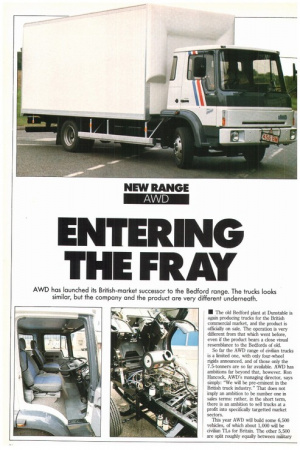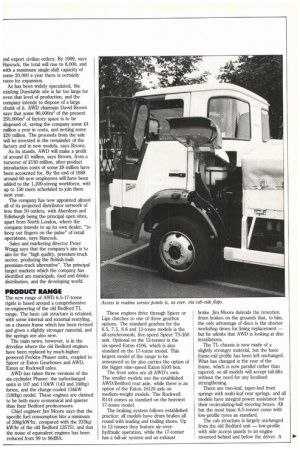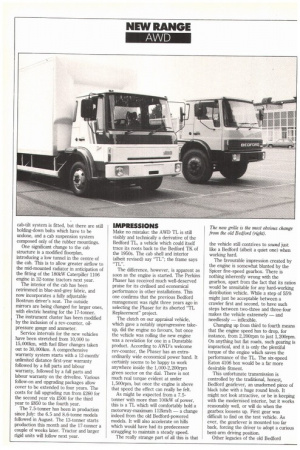ENTERING THE FRAY
Page 26

Page 27

Page 28

Page 29

If you've noticed an error in this article please click here to report it so we can fix it.
AWD has launched its British-market successor to the Bedford range. The trucks looks similar, but the company and the product are very different underneath.
• The old Bedford plant at Dunstable is again producing trucks for the British commercial market, and the product is officially on sale. The operation is very different from that which went before, even if the product bears a close visual resemblance to the Bedfords of old.
So far the AWD range of civilian trucks is a limited one, with only four-wheel rikids announced, and of those only the 7.5-tonners are so far available. AWD has ambitions far beyond that, however. Ron Hancock, AWD's managing director, says simply: "We will be pre-eminent in the British truck industry." That does not imply an ambition to be number one in sales terms: rather, in the short term, there is an ambition to sell trucks at a profit into specifically targetted market sectors.
This year AWD will build some 6,500 vehicles, of which about 1,000 will be civilian TLs for Britain. The other 5,500 are split roughly equally between military
and export civilian orders. By 1989, says Hancock, the total will rise to 8,000, and with a maximum single-shift capacity of some 20,000 a year there is certainly room for expansion.
As has been widely speculated, the existing Dunstable site is far too large for even that level of production, and the company intends to dispose of a large chunk of it. AWD chairman David Brown says that some 90,000m2 of the present 250,000m2 of factory space is to be disposed of, saving the company some 24 million a year in costs, and netting some 220 million. The proceeds from the sale will be invested in the remainder of the factory and in new models, says Brown.
As its stands, AWD will make a profit of around E1 million, says Brown, from a turnover of 2130 million, after product introduction costs of some 28 million have been accounted for. By the end of 1988 around 60 new employees will have been added to the 1,200-strong workforce, with up to 150 more scheduled to join them next year.
The company has now appointed almost all of its projected distributor network of less than 50 outlets, with Aberdeen and Edinburgh being the principal open sites, apart from North London, where the company intends to up its own dealer, "to keep our fingers on the pulse" of retail operations, says Hancock.
Sales and marketing director Peter Wragg says that the company's aim is to aim for the "high quality, premium-truck sector, producing the British-built premium-truck alternative". The principal target markets which the company has identified are municipals, food and drinks distribution, and the developing world.
PRODUCT RANGE
The new range of AWD 6.5-17-tonne rigids is based around a comprehensive re-engineering of the old Bedford TL range. The basic cab structure is retained, with some internal and external restyling, on a chassis frame which has been revised and given a slightly stronger material, and the springs are also new.
The main news, however, is in the driveline where the old Bedford engines have been replaced by much-higherpowered Perkins Phaser units, coupled to Spicer or Eaton Gearboxes and AWD, Eaton or Rockwell axles.
AWD has taken three versions of the six-cyclinder Phaser: the turbocharged units in 107 and 110kW (143 and 160hp) forms, and the charge-cooled 134kW (180hp) model. These engines are claimed to be both more economical and quieter than their Bedford predecessors.
Chief engineer Jim Moore says that the specific fuel consumption hits a minimum of 208g/kW/hr, compared with the 233kg/ kW/hr of the old Bedford 135TD, and that the noise of equivalent engines has been reduced from 99 to 96dBA. These engines drive through Spicer or Lipe clutches to one of three gearbox options. The standard gearbox for the 6.5, 7.5, 8.6 and 13-tonne models is the all-synchromesh, five-speed Spicer T5-350 unit. Optional on the 13-tonner is the six-speed Eaton 4106, which is also standard on the 17-tonne model. This largest model of the range to be announced so far also carries the option of the bigger nine-speed Eaton 6109 box.
The front axles are all AWD's own. The smaller models use the established AWD/Bedford rear axle, while there is an option of the Eaton 16120 axle on medium-weight models. The Rockwell R144 comes as standard on the heaviest 17-tonne model.
The braking system follows established practice: all models have drum brakes all round with leading and trailing shoes. Up to 13 tonnes they feature air-overhydraulic operation, while the 17-tonner has a full-air system and an exhaust brake. Jim Moore defends the retention drum brakes on the grounds that, to him, the only advantage of discs is the shorter workshop times for lining replacement — but he admits that AWD is looking at disc installations.
The TL chassis is now made of a slightly stronger material, but the basic frame-rail profile has been left unchanged. What has changed is the rear of the frame, which is now parallel rather than tapered, so all models will accept tail-lifts without the need for any localised strengthening.
There are two-leaf, taper-leaf front springs with multi-leaf rear springs, and all models have integral power assistance for their recirculating-ball steering boxes. All but the most basic 6.5-tonner come with low-profile tyres as standard.
The cab structure is largely unchanged from the old Bedford unit — low-profile with side access panels to an engine mounted behind and below the driver. A cab-tilt system is fitted, but there are still holding-down bolts which have to be undone, and a cab suspension system composed only of the rubber mountings.
One significant change to the cab structure is a modified floorplan, introducing a low tunnel in the centre of the cab. This is to allow greater airflow to the mid-mounted radiator in anticipation of the fitting of the 180kW Caterpiller 1106 engine in 32-tonne tractors next year.
The interior of the cab has been retrimmed in blue-and-grey fabric, and now incorporates a fully adjustable Bostrum driver's seat. The outside mirrors are being changed for larger ones, with electric heating for the 17-tonner. The instrument cluster has been modified by the inclusion of a rev-counter, oilpressure gauge and ammeter.
Service intervals for the new vehicles have been stretched from 10,000 to 15,000km, with fuel filter changes taken out to 30,000km. A comprehensive warranty system starts with a 12-month/ unlimited distance first-year warranty followed by a full parts and labour warranty, followed by a full parts and labour warranty on the driveline. Various follow-on and upgrading packages allow cover to be extended to four years. The costs for full upgrading run from £260 for the second year via £500 for the third year to £850 to the fourth year.
The 7.5-tonner has been in production since July: the 6.5 and 8.6-tonne models followed in August. The 13-tonner starts production this month and the 17-tonner a couple of weeks later. Tractor and larger rigid units will follow next year.
IMPRESSIONS
Make no mistake: the AWD TL is still visibly and technically a derivative of the Bedford TL, a vehicle which could itself trace its roots back to the Bedford TK of the 1950s. The cab shell and interior (albeit revised) say "TL"; the frame says "TL".
The difference, however, is apparent as soon as the engine is started. The Perkins Phaser has received much well-deserved praise for its civilised and economical performance in other installations. This one confirms that the previous Bedford management was right three years ago in selecting the Phaser for its aborted "TL Replacement" project.
The clutch on our appraisal vehicle, which gave a notably unprogressive takeup, did the engine no favours, but once the vehicle was rolling the new engine was a revelation for one in a Dunstable product. According to AWD's welcome rev-counter, the Phaser has an extraordinarily wide economical power band. It certainly seems to be happy to work anywhere inside the 1,000-2,200rpm green sector on the dial. There is not much real torque evident at under 1,500rpm, but once the engine is above that speed the effect can really be felt.
As might be expected from a 7.5tomer with more than 100kW of power, this is a TL which will comfortably hold a motorway-maximum 112km/h — a change indeed from the old Bedford-powered models. It will also accelerate on hills which would have had its predecessor struggling to maintain a steady speed.
The really strange part of all this is that the vehicle still contrives to sound just like a Bedford (albeit a quiet one) when working hard.
The favourable impression created by the engine is somewhat blunted by the Spicer five-speed gearbox. There is nothing inherently wrong with the gearbox, apart from the fact that its ratios would be unsuitable for any hard-working distribution vehicle. While a step of 55% might just be acceptable between a crawler first and second, to have such steps between two-three and three-four makes the vehicle extremely — and needlessly — inflexible.
Changing up from third to fourth means that the engine speed has to drop, for instance, from 2,200rpm to just 1,200rpm. On anything but flat roads, such gearing is impractical, and it is only the plentiful torque of the engine which saves the performance of the TL. The six-speed Eaton 4106 box would be a far more desirable fitment.
'This unfortunate transmission is controlled by the traditional, honest, Bedford gearlever, an unadorned piece of black tube with a huge round knob. It might not look attractive, or be in keeping with the modernised interior, but it works reasonably well, or will do when the gearbox loosens up. First gear was difficult to find on the test vehicle. As ever, the gearlever is mounted too far back, forcing the driver to adopt a curious bent-arm driving position.
Other legacies of the old Bedford interiors are the steering-column contol stalks and the parking-brake lever. The stalks are atractive and easy to use, but unfortunately they follow to the old British pattern instead of the now-near-universal positions with indicators/lights on the left and wipers on the right. The parking brake is still the awkward old lever tucked away to the right of the driver's seat. Access to it, always difficult, has been worsened by the fitting of, for the first time, a decent, but bulkier driver's seat.
Short of redesigning the braking system to allow repositioning the brake lever, the only solution would appear to be the modification of the door inner trim to remove the door pocket. With the vast amount of storge space available on the redesigned shelf behind the seats this space would not be missed.
The longer springs have improved the traditionally choppy Bedford ride, but the steering is a little vague, especially at speed. The brakes bear little resemblance to the hissing, squeaking Bedford brakes of yore, having superb feel. Whether they stop the vehicle as well as the disc brakes fitted to most 7.5-tonners will only be established by a full road test.
Other than these various changes, the recipe on the TL is very much as before. It is certainly a much-improved truck dynamically, which should make it a more attractive proposition for the operator. It is still very much an undated TL, however. The real pity of it is that this update wasn't carried out five years ago, so that AWD would, by now, have been introducing its truly modern successor.
by Allan Winn














































